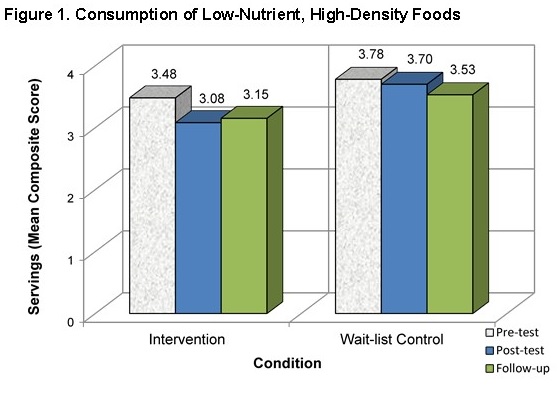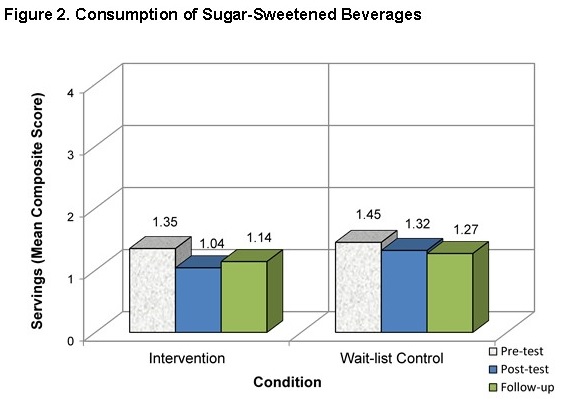The Implementation Guide is a resource for implementing this evidence-based program. It provides important information about the staffing and functions necessary for administering this program in the user’s setting. Additionally, the steps needed to carry out the program, relevant program materials, and information for evaluating the program are included. The Implementation Guide can be viewed and downloaded on the Program Materials page.
Program Synopsis
Designed to improve dietary habits and increase physical activity among fourth-grade children, this school-based intervention consists of seven lessons in which students learn about nutrition and exercise and a workbook students use to record their progress and complete family homework assignments. The study showed decreases in the consumption of low-nutrient, high-density foods and sugar-sweetened beverages.
Program Highlights
Program Materials
Preview and order the materials from the developer
Implementation Guide
Download Implementation Guide
Insights from the Cancer Control Field
See how implementers have used this program in the field
Program Scores
The Need
Currently in the United States, 13.7 million children and adolescents are obese. Many health-related conditions are linked to obesity, including heart disease, stroke, type 2 diabetes, and certain types of cancer. Obesity can be prevented through healthy eating habits and physical activity. Schools have a unique opportunity to teach students about the importance of healthy behaviors. To improve overall student health, the Centers for Disease Control and Prevention (CDC) recommends that schools promote healthy dietary behaviors and physical activity through programs that include students and their families. In addition, CDC recommends that parents help children maintain a healthy weight by balancing the calories their child consumes from food and beverages with the calories their child uses through physical activity and normal growth. School-based interventions that encourage nutrition and physical activity among children are vital to decrease rates of obesity and related health problems.
The Program
Nutrition Pathfinders is a school-based education program that promotes nutrition and physical activity among fourth-grade children and their parents. Developed by Dairy Council of California to encourage children’s healthy eating habits and attitudes (e.g., self-efficacy, outcome expectations), Nutrition Pathfinders is based on the health belief model and social cognitive theory. The goal of the program is to help students make healthy choices about food and physical activity every day.
The intervention consists of seven 45- to 60-minute lessons delivered by classroom teachers over 4 to 10 weeks, depending on the classroom’s other scheduled activities. During each lesson, the students learn about the following topics related to nutrition and exercise and apply their knowledge through interactive activities, simulations, and reflections:
-- Lesson 1: Five food groups, amount of moderate to vigorous physical activity needed daily, and examples of those activities
-- Lesson 2: Main nutrients in each food group and the health benefits of those nutrients, benefits of eating a wide variety of foods each day, and benefits of drinking water and hydration
-- Lesson 3: Serving sizes for foods in the five food groups and number of servings from each food group needed daily
-- Lesson 4: Information on the nutrition facts food label
-- Lesson 5: Importance of a balanced dinner; how to select a balanced dinner; importance of nutritious snacks; the recommended amount of moderate- to vigorous-level physical activity needed daily; and examples of physical activities at a low, moderate, and vigorous level
-- Lesson 6: Importance of a balanced breakfast, how to select a balanced breakfast, and how to analyze daily physical activity and meet daily physical activity requirements
-- Lesson 7: How to analyze daily food and physical activity choices, compare these with recommendations, and improve choices to meet the daily requirements
Classroom teachers deliver the program using instructional materials (e.g., teacher guide, food pictures, vocabulary cards) that are all available online for download and print. Students receive a workbook that they use to record their progress and achievement, and the data are shared with parents at parent–teacher conferences. The workbook also has family homework assignments that students complete with parents to reinforce the skills they are learning in the classroom. The student workbook, available in English and Spanish, can be ordered online at no cost within California and for purchase outside of California.
Community Preventive Services Task Force Finding
 This program uses an intervention approach recommended by the Community Preventive Services Task Force: enhanced school-based physical education interventions (Physical Activity).
This program uses an intervention approach recommended by the Community Preventive Services Task Force: enhanced school-based physical education interventions (Physical Activity).
Time Required
-- 45–60 minutes to deliver each lesson to students
Intended Audience
The intervention is intended for children in the fourth grade.
Suitable Settings
This intervention is intended to be implemented in school-based and home settings.
Required Resources
Required resources to implement the program include the following:
-- Nutrition Pathfinders website
For costs associated with this program, please contact the developer, Trina Robertson. (See products page on the EBCCP website for developer contact information.)
About the Study
A randomized controlled trial compared the Nutrition Pathfinders intervention with a wait-list control condition among fourth graders located throughout California. Researchers recruited 47 fourth-grade classrooms from schools listed in the Dairy Council of California’s database as eligible to teach nutrition. Randomization occurred at the classroom level, resulting in 27 intervention classrooms and 20 control classrooms. The control group received regular classroom instruction without nutrition information until the end of the study and then received the Nutrition Pathfinders program materials.
In total, 1,713 students were enrolled: 971 in the intervention group and 742 in the control group. The sample was 38% Hispanic, 32% White, 15% Asian, 8% African American, and 7% “other.” The average age of participants was 9 years, and 52% of the students were boys. Forty-seven percent of the students received free or reduced-price lunch.
The main outcome measures—consumption of low-nutrient, high-density foods and consumption of sugar-sweetened beverages—were assessed at baseline (pre-test), 10 weeks after baseline (post-test), and 3 months after baseline (follow-up). Dietary intake was measured with a 22-item modified version of the elementary-level School Physical Activity and Nutrition Questionnaire (SPAN). Students were asked the number of each food item in various food categories they consumed on the previous day and answered either none, 1 time, 2 times, or 3 or more times. Composite scores of average daily food intake were calculated for each food category by summing responses to the items in that category. Low-nutrient, high-density foods included fries/snack chips, punch/sports drinks, regular/diet soda, baked desserts, and candy, and sugar-sweetened beverages included regular/diet soda and punch/sports drinks.
In addition to the SPAN, students completed other self-report survey items at pre-test, post-test, and follow-up to assess secondary outcomes:
-- Nutrition self-efficacy was measured with four items.
-- Nutrition outcome expectations were measured with six items.
-- Six areas of nutrition knowledge were measured: food groups (six items), main nutrients (three items), main nutrient functions (three items), balanced breakfast choices (two items), healthy snack choices (two items), and balanced dinner choices (one item).
Additional secondary outcomes were assessed using a 40-item parent survey administered at pre-test and post-test. The survey measured perceptions of the child’s interest in the main food groups (milk, grains, fruits, vegetables, and proteins); the frequency with which the child asks for certain foods, and the child’s nutrition-related behavior.
Key Findings

- From pre-test to post-test, the intervention group had a greater decrease in consumption of low-nutrient, high-density foods than did the control group (p<.05); however, from pre-test to follow-up, there were no significant differences between the two groups.

- From pre-test to post-test, the intervention group had a greater decrease in consumption of sugar-sweetened beverages than did the control group (p<.05); however, from pre-test to follow-up, there were no significant differences between the two groups.
Additional Findings
- From pre-test to post-test, the intervention group had improvement in nutrition knowledge relative to the control group (food groups, p<.001; main nutrients, p<.001; nutrient functions, p<.001; snack choices, p<.001; dinner choices, p<.001). From pre-test to follow-up, the intervention group continued to have improvement in nutrition knowledge relative to the control group (food groups, p<.001; main nutrients, p<.001; nutrient functions, p<.001; snack choices, p<.001; dinner choices, p<.01).
- From pre-test to post-test, the intervention group had improvement in attitudes relative to the control group (self-efficacy, p<.05; outcome expectations, p<.01).
- From pre-test to post-test, the intervention group had improvements in children’s interest in the main food groups (p<.01), children’s behaviors related to nutrition (p<.001), and children asking for new foods (p<.01) relative to the control group.


